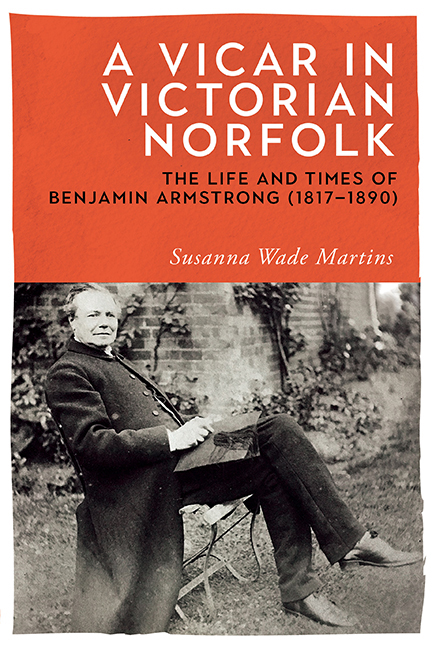Book contents
- Frontmatter
- Contents
- List of Illustrations
- Acknowledgements
- Foreword
- Author's Note
- Map
- Introduction
- I The Early Years
- 1 Early Life
- 2 The Move to Dereham
- II Public Life
- 3 The Norfolk Clergy
- 4 Church Life
- 5 The Building Legacy
- 6 Schools
- 7 Town Life
- III Family and Friends
- 8 Family Life
- 9 Friends
- IV Later Life
- 10 The Later Years
- 11 Armstrong: A Man of His Time
- Bibliography
- Timeline
- Index
9 - Friends
Published online by Cambridge University Press: 14 August 2020
- Frontmatter
- Contents
- List of Illustrations
- Acknowledgements
- Foreword
- Author's Note
- Map
- Introduction
- I The Early Years
- 1 Early Life
- 2 The Move to Dereham
- II Public Life
- 3 The Norfolk Clergy
- 4 Church Life
- 5 The Building Legacy
- 6 Schools
- 7 Town Life
- III Family and Friends
- 8 Family Life
- 9 Friends
- IV Later Life
- 10 The Later Years
- 11 Armstrong: A Man of His Time
- Bibliography
- Timeline
- Index
Summary
During his thirty-eight years as vicar of Dereham, Armstrong gathered a wide circle of acquaintances around him. He was a regular guest at dinner, luncheon and garden parties in the neighbourhood. He was well aware of the importance of rank and always noted the names of the more aristocratic guests when he went out. Dinners with the Brampton Gurdons at Letton Hall always impressed him. When Helen was launched into local society he was glad that it happened at a dinner party at ‘so good a house’ (18/9/61). The family knew everyone at the Dereham Assembly, which was always attended by the best families (12/11/61). However, he had few close friends. The local doctor, Horace Hastings, was one of the closest with whom he was on ‘pipe-smoking’ terms.
A second local friend was George Carthew, solicitor and antiquarian, who was his churchwarden for nearly twenty-five years. Articles by Carthew appeared regularly in Norfolk Archaeology from 1849 and his three-volume study of the parishes within Launditch Hundred was published in 1879. His lecture to the Institute on ‘The Town We Live In’ (18/4/55) was published a couple of years later. On his death in October 1882, Armstrong described him as ‘my old friend. When I first came he was the only intelligent churchman in the place, and though my position was a very difficult one in those days, he always supported me. He was a great archaeologist and a man of considerable taste’ (21/10/82).
Another antiquarian friend of his later years was Augustus Jessopp, who became vicar of Scarning in 1879. When dining at the Scarning vicarage a few years later he described the conversation as ‘amusing and instructive as it always is there’ (20/7/82). In 1883 Jessopp and his wife were frequently listed among Armstrong's dinner guests. Armstrong found it difficult to give dinner parties which included both ‘town’ and ‘country’. Jessopp was in the country category, but on one occasion some of the guests (‘although all professional’) were from the town. ‘Consequently they did not amalgamate as well as we could wish. This absurd distinction renders it difficult for a town parson to give a party whereas the country parson has no town parishioners to pay attention to’ (17/1/82).
- Type
- Chapter
- Information
- A Vicar in Victorian NorfolkThe Life and Times of Benjamin Armstrong (1817–1890), pp. 223 - 238Publisher: Boydell & BrewerPrint publication year: 2018

